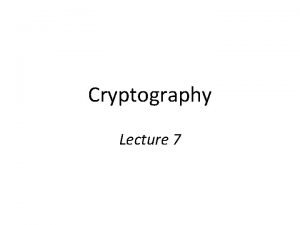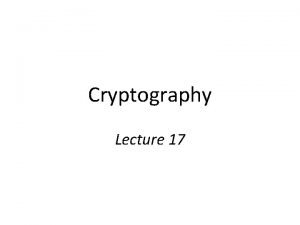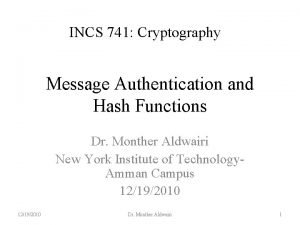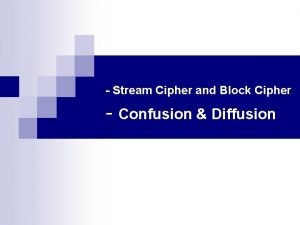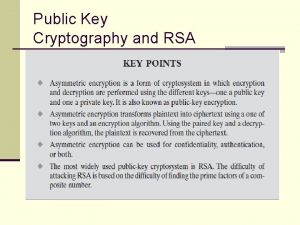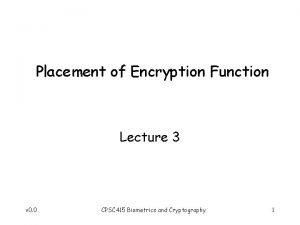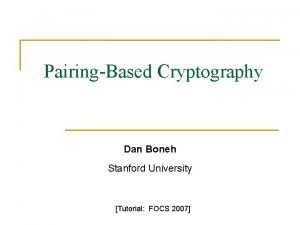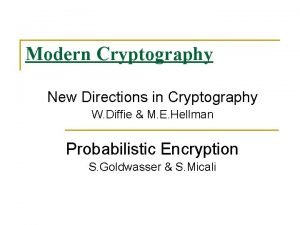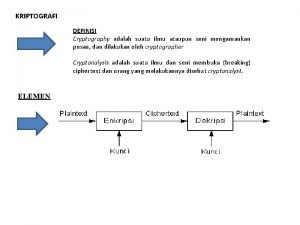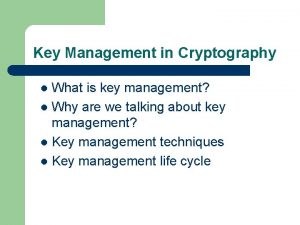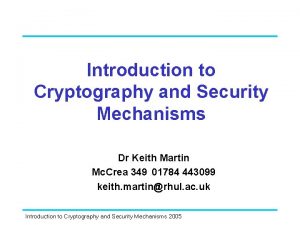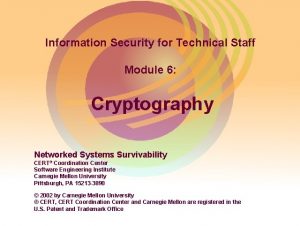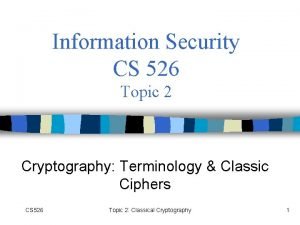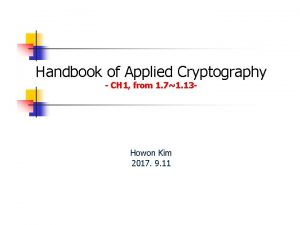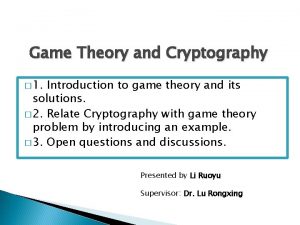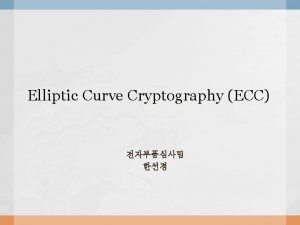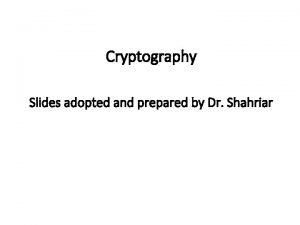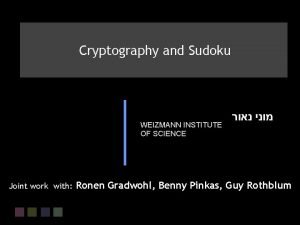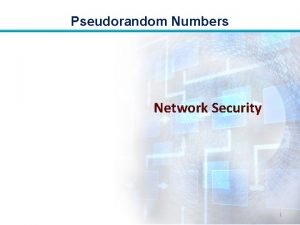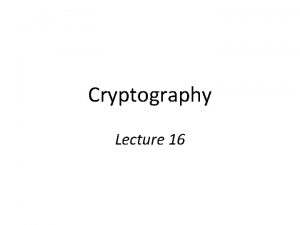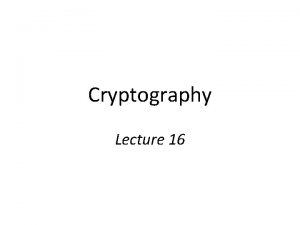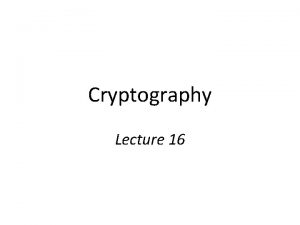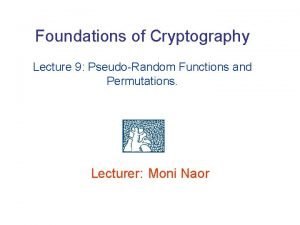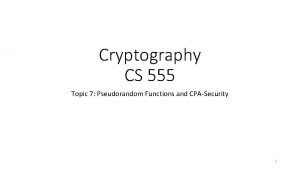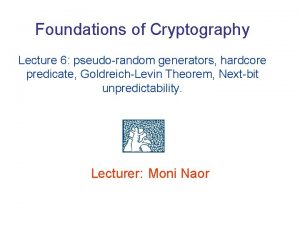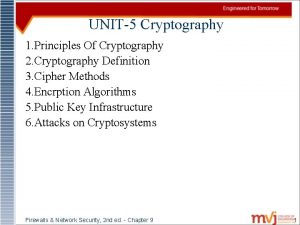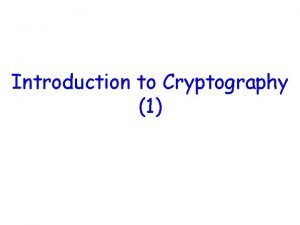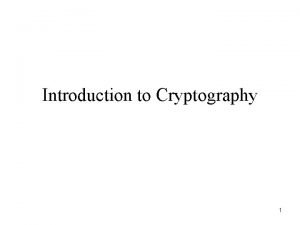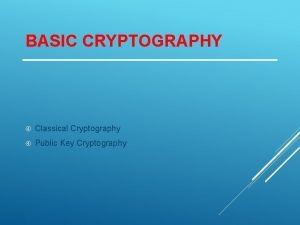Cryptography Lecture 7 Pseudorandom functions Keyed functions Let




















![Analysis • Let µ(n) = Pr[Priv. CPAAdv, Π(n) = 1] • Let q(n) be Analysis • Let µ(n) = Pr[Priv. CPAAdv, Π(n) = 1] • Let q(n) be](https://slidetodoc.com/presentation_image_h/a91e12a3d1d632ee26eedd5e8cd22b33/image-21.jpg)

![Analysis • Since F is pseudorandom… | µ(n) – Prf[Df(·) =1] | ≤ ε(n) Analysis • Since F is pseudorandom… | µ(n) – Prf[Df(·) =1] | ≤ ε(n)](https://slidetodoc.com/presentation_image_h/a91e12a3d1d632ee26eedd5e8cd22b33/image-23.jpg)













- Slides: 36

Cryptography Lecture 7

Pseudorandom functions

Keyed functions • Let F: {0, 1}* x {0, 1}* be an efficient, deterministic algorithm – Define Fk(x) = F(k, x) – The first input is called the key • Assume F is length preserving: F(k, x) only defined if |k|=|x|, in which case |F(k, x)| = |k| = |x| • Choosing a uniform k {0, 1}n is equivalent to choosing the function Fk : {0, 1}n – I. e. , for fixed key length n, the algorithm F defines a distribution over functions in Funcn!

World 0 World 1 k {0, 1}n chosen uniformly at random Fk … f xt f(xt) ? ? x 1 Fk(x 1) (poly-time) … f Funcn chosen uniformly at random x 1 f(x 1) xt Fk(xt)

Pseudorandom permutations (PRPs) • Let f Funcn • f is a permutation if it is a bijection – This means that the inverse f-1 exists • Let Permn Funcn be the set of permutations • What is |Permn|?

Pseudorandom permutations • Let F be a length-preserving, keyed function • F is a keyed permutation if – Fk is a permutation for every k – Fk-1 is efficiently computable (where Fk-1(Fk(x)) = x) • F is a pseudorandom permutation if Fk , for uniform key k {0, 1}n, is indistinguishable from a uniform permutation f Permn

Note • For large enough n, a random permutation is indistinguishable from a random function • So in practice, PRPs are also good PRFs • Proof in the book (required!)

PRFs vs. PRGs • PRF F immediately implies a PRG G: – Define G(k) = Fk(0… 0) | Fk(0… 1) – I. e. , G(k) = Fk(<0>) | Fk(<1>) | Fk(<2>) | …, where <i> denotes the n-bit encoding of i • PRF can be viewed as a PRG with random access to exponentially long output – The function Fk can be viewed as the n 2 n-bit string Fk(0… 0) | … | Fk(1… 1)

Do PRFs/PRPs exist? • They are a stronger primitive than PRGs… – …though can be built from PRGs • In practice, block ciphers are used

Block ciphers • Block ciphers are practical constructions of pseudorandom permutations • No asymptotics: F: {0, 1}n x {0, 1}m – n = “key length” – m = “block length” • Hard to distinguish Fk from uniform f Permm even for attackers running in time 2 n

AES • Advanced encryption standard (AES) – Standardized by NIST in 2000 based on a public, worldwide competition lasting over 3 years – Block length = 128 bits – Key length = 128, 192, or 256 bits • Will not discuss details later in the course • No real reason to use anything else

CPA-security • Fix , A • Define a randomized exp’t Priv. KCPAA, (n): 1. k Gen(1 n) 2. A(1 n) interacts with an encryption oracle Enck(·), and then outputs m 0, m 1 of the same length 3. b {0, 1}, c Enck(mb), give c to A 4. A can continue to interact with Enck(·) 5. A outputs b’; A succeeds if b = b’, and experiment evaluates to 1 in this case

CPA-security • is secure against chosen-plaintext attacks (CPA-secure) if for all PPT attackers A, there is a negligible function such that Pr[Priv. KCPAA, (n) = 1] ≤ ½ + (n)

CPA-secure encryption • Let F be a length-preserving, keyed function • Gen(1 n): choose a uniform key k {0, 1}n • Enck(m), for |m| = |k|: – Choose uniform r {0, 1}n (nonce/initialization vector) – Output ciphertext < r, Fk(r) m > • Deck(c 1, c 2): output c 2 Fk(c 1) • Correctness is immediate

r key F ciphertext message pseudorandom

Security? • Theorem: if F is a pseudorandom function, then this scheme is CPA-secure

Note • The key may be as long as the message… • …but the same key can be used to safely encrypt multiple messages

Security? • Theorem: if F is a pseudorandom function, then this scheme is CPA-secure • Proof by reduction… • Let denote the scheme

PR/random m f(r) r ← {0, 1}n m r, f(r) m D

PR/random m 0 , m 1 f(r*) r* ← {0, 1}n mb b←{0, 1} r*, f(r*) mb b’ if (b=b’) output 1 D
![Analysis Let µn PrPriv CPAAdv Πn 1 Let qn be Analysis • Let µ(n) = Pr[Priv. CPAAdv, Π(n) = 1] • Let q(n) be](https://slidetodoc.com/presentation_image_h/a91e12a3d1d632ee26eedd5e8cd22b33/image-21.jpg)
Analysis • Let µ(n) = Pr[Priv. CPAAdv, Π(n) = 1] • Let q(n) be a bound on the number of encryption queries made by attacker • If f = Fk for uniform k, then the view of Adv is exactly as in Priv. CPAAdv, Π(n) Prk {0, 1}n[DFk(·) =1] = Pr[Priv. CPAAdv, Π(n) = 1] = µ(n)

Analysis • If f is uniform, there are two sub-cases – r* was used for some other ciphertext (call this event Repeat) – r* was not used for some other ciphertext • Prf[Df(·) =1] ≤ Prf[Df(·) =1| Repeat] + Pr[Repeat] – Pr[Repeat] ≤ q(n)/2 n – Prf[Df(·) =1 | Repeat] = ½
![Analysis Since F is pseudorandom µn PrfDf 1 εn Analysis • Since F is pseudorandom… | µ(n) – Prf[Df(·) =1] | ≤ ε(n)](https://slidetodoc.com/presentation_image_h/a91e12a3d1d632ee26eedd5e8cd22b33/image-23.jpg)
Analysis • Since F is pseudorandom… | µ(n) – Prf[Df(·) =1] | ≤ ε(n) µ(n) ≤ Prf[Df(·) =1] + ε(n) ≤ ½ + q(n)/2 n + ε(n) • For any polynomial q, the term q(n)/2 n is negligible Pr[Priv. CPAAdv, Π(n) = 1] = µ(n) ≤ ½ + ε’(n) QED

Real-world security? • The security bound we proved is tight • What happens if a nonce r is ever reused? • What is the probability that the nonce used in some challenge ciphertext is also used for some other ciphertext? • What happens to the bound if the nonce is chosen non-uniformly?

CPA-secure encryption • We have shown a CPA-secure encryption scheme based on any block cipher/PRF – Enck(m) = <r, Fk(r) m> • Drawbacks? – A 1 -block plaintext results in a 2 -block ciphertext – Only defined for encryption of n-bit messages

Encrypting long messages? • Recall that CPA-security for the encryption of multiple messages • So, can encrypt the message m 1, …, mt as Enck(m 1), Enck(m 2), …, Enck(mt) – This is also CPA-secure!

m 1, …, mt c 1 Enck(m 1) … ct Enck(mt) . . . k c 1, …, ct ct k

Drawback • The ciphertext is twice the length of the plaintext – I. e. , ciphertext expansion by a factor of two • Can we do better? • Modes of operation – Block-cipher modes of operation – Stream-cipher modes of operation

CTR mode • Enck(m 1, …, mt) // note: t is arbitrary – Choose ctr {0, 1}n, set c 0 = ctr – For i=1 to t: • ci = mi Fk(ctr + i) – Output c 0, c 1, …, ct • Decryption? • Ciphertext expansion is just 1 block

CTR mode ctr m 1 c 0 ctr+1 ctr+2 Fk Fk c 1 m 2 ctr+t … Fk mt ct

CTR mode • Theorem: If F is a pseudorandom function, then CTR mode is CPA-secure • Proof sketch: The sequence Fk(ctri + 1), …, Fk(ctri + t) used to encrypt the ith message is pseudorandom – Moreover, it is independent of every other such sequence unless ctri + j = ctri’ + j’ for some i, j, i’, j’ • Just need to bound the probability of that event

CBC mode • Enck(m 1, …, mt) // note: t is arbitrary – Choose random c 0 {0, 1}n (also called the IV) – For i=1 to t: • ci = Fk(mi ci-1) – Output c 0, c 1, …, ct • Decryption? – Requires F to be invertible • Ciphertext expansion is just 1 block

CBC mode IV c 0 m 1 m 2 mt Fk Fk c 1 c 2 … Fk ct

CBC mode • Theorem: If F is a pseudorandom permutation, then CBC mode is CPA-secure • Proof is more complicated than for CTR mode

ECB mode • Enck(m 1, …, mt) = Fk(m 1), …, Fk(mt) • Deterministic – Not CPA-secure! • Can tell from the ciphertext whether mi = mj – Not even EAV-secure!

Not just a theoretical problem! original encrypted using ECB mode (Taken from http: //en. wikipedia. org and derived from images created by Larry Ewing (lewing@isc. tamu. edu) using The GIMP. )
 John 10:22-28
John 10:22-28 Keyed and keyless transposition ciphers
Keyed and keyless transposition ciphers Keyed name in letter
Keyed name in letter Block style memorandum
Block style memorandum Keyed permutation
Keyed permutation Keyed permutation
Keyed permutation 01:640:244 lecture notes - lecture 15: plat, idah, farad
01:640:244 lecture notes - lecture 15: plat, idah, farad Authentication functions in cryptography
Authentication functions in cryptography Indirect object answers the question
Indirect object answers the question America my home sweet home
America my home sweet home He who has ears, let him hear he who has eyes let him see
He who has ears, let him hear he who has eyes let him see New directions in cryptography
New directions in cryptography Confusion vs diffusion
Confusion vs diffusion Blaise de vigenere cryptography
Blaise de vigenere cryptography Principles of public key cryptosystems
Principles of public key cryptosystems Placement of encryption function in cryptography
Placement of encryption function in cryptography Dan boneh stanford
Dan boneh stanford Dan boneh coursera
Dan boneh coursera Wireless security in cryptography and network security
Wireless security in cryptography and network security 1976 new directions in cryptology
1976 new directions in cryptology Pengertian cryptography
Pengertian cryptography Key management in cryptography
Key management in cryptography Cryptography
Cryptography Module 06 basic cryptography
Module 06 basic cryptography Cryptography terminology
Cryptography terminology Cryptography
Cryptography Handbook applied cryptography
Handbook applied cryptography Cryptography board game
Cryptography board game Motivationsbasis
Motivationsbasis Crytographers
Crytographers Cryptography slides
Cryptography slides Cryptography summary
Cryptography summary A murder has been committed
A murder has been committed Cryptography definition
Cryptography definition Moni naor
Moni naor Cryptography security services
Cryptography security services Security services in cryptography
Security services in cryptography




